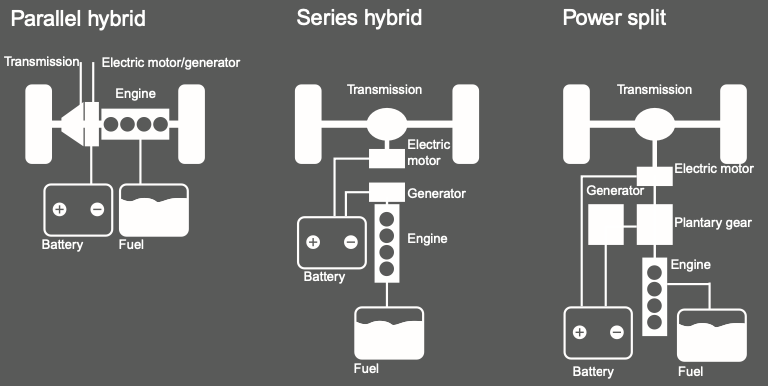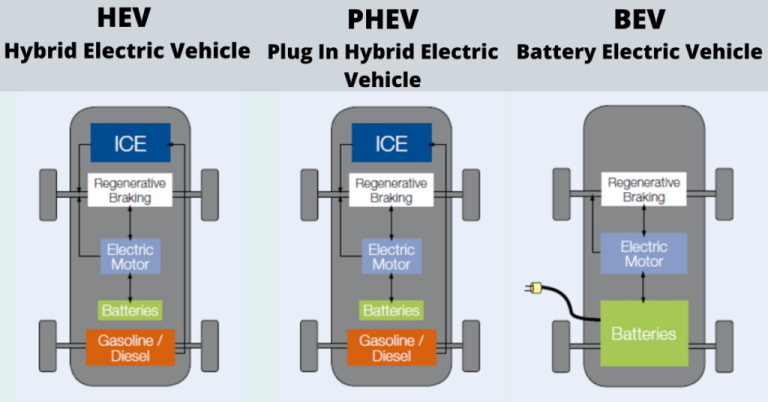Hybrid vehicles have become increasingly popular over the past few years, thanks to their ability to run on both gasoline and electric power. There are three main types of hybrid vehicles available on the market today, each with their own unique benefits and drawbacks. In this blog, we’ll take a closer look at these three types of hybrid vehicles and what makes them different.
- Parallel Hybrid Vehicles
Parallel hybrid vehicles, also known as “full hybrids,” are the most common type of hybrid vehicle on the market today. These vehicles have both an electric motor and an internal combustion engine that work together to power the vehicle. In parallel hybrids, the electric motor and the engine can work separately or together, depending on the driving conditions.
One of the main benefits of parallel hybrids is that they can run on either electric power or gasoline, making them very versatile. They also tend to be more fuel-efficient than traditional gasoline-powered vehicles, since the electric motor can assist the engine during acceleration and other high-power demands. However, parallel hybrids can be more expensive than traditional gasoline-powered vehicles, and they may require more maintenance due to the complex hybrid powertrain.
- Series Hybrid Vehicles
Series hybrid vehicles, also known as “range extenders,” are similar to parallel hybrids in that they have both an electric motor and an internal combustion engine. However, in series hybrids, the electric motor is the primary power source for the vehicle, while the engine acts as a generator to charge the batteries that power the motor.
Series hybrids are often more fuel-efficient than parallel hybrids, since the electric motor is the primary source of power for the vehicle. They also tend to have a longer electric-only range than parallel hybrids, making them a good choice for drivers who do a lot of city driving. However, series hybrids can be more expensive than parallel hybrids, and they may not offer the same level of performance as parallel hybrids.
- Plug-In Hybrid Vehicles
Plug-in hybrid vehicles, also known as “PHEVs,” are similar to parallel hybrids in that they have both an electric motor and an internal combustion engine. However, in PHEVs, the battery can be recharged by plugging the vehicle into an electrical outlet, allowing the vehicle to run on electric power alone for a certain distance.
PHEVs tend to be more fuel-efficient than both parallel and series hybrids, since they can run on electric power alone for a certain distance. They also tend to have a longer electric-only range than series hybrids, making them a good choice for drivers who want to minimize their use of gasoline. However, PHEVs can be more expensive than both parallel and series hybrids, and they may require more maintenance due to the complex hybrid powertrain.

In conclusion, hybrid vehicles come in three main types – parallel hybrids, series hybrids, and plug-in hybrids. Each type has its own unique benefits and drawbacks, so it’s important to do your research and choose the type that best fits your driving needs and budget. With their combination of electric and gasoline power, hybrid vehicles offer a great way to reduce fuel consumption and minimize your impact on the environment.
- Parallel Hybrid Vehicles
Parallel hybrid vehicles are the most common type of hybrid on the market, and they work by using both an internal combustion engine and an electric motor to power the vehicle. The electric motor is typically used for low-speed driving and acceleration, while the engine kicks in at higher speeds or when more power is needed.
One of the benefits of parallel hybrids is that they can switch between electric and gasoline power automatically, so drivers don’t need to worry about manually switching between the two. They can also be more fuel-efficient than traditional gasoline-powered vehicles, and they emit less greenhouse gases.
However, parallel hybrids can be more expensive than traditional vehicles, and they may require more maintenance due to the added complexity of the hybrid powertrain. Additionally, some drivers may not like the sensation of the engine turning off and on, or the lack of noise when driving in electric mode.
- Series Hybrid Vehicles
Series hybrid vehicles are similar to parallel hybrids, but with one key difference – the electric motor is the primary power source for the vehicle, and the engine is only used to generate electricity to charge the batteries that power the motor. This means that the engine doesn’t directly power the wheels like it does in a parallel hybrid.
One of the benefits of series hybrids is that they can be more fuel-efficient than parallel hybrids, since the electric motor is the primary source of power. They also tend to be quieter and smoother to drive, since the engine isn’t directly powering the wheels. Additionally, some drivers may prefer the electric-only driving mode, which can offer a smooth, quiet ride with zero emissions.
However, series hybrids can be more expensive than parallel hybrids, and they may not offer the same level of performance or power as parallel hybrids. Additionally, the battery range may be limited, so drivers may need to rely on the engine to generate electricity for longer trips.
- Plug-In Hybrid Vehicles
Plug-in hybrid vehicles, or PHEVs, are similar to parallel hybrids, but with the added ability to plug into an electrical outlet to recharge the battery. This means that the vehicle can run on electric power alone for a certain distance, usually between 20-50 miles depending on the model.
One of the benefits of PHEVs is that they offer the most flexibility in terms of driving mode – drivers can choose to use electric-only mode for short trips or gasoline mode for longer trips. They also tend to be more fuel-efficient than both parallel and series hybrids, since they can run on electric power alone for a certain distance. Additionally, the ability to plug in means that drivers can take advantage of off-peak electricity rates to save money on charging.
However, PHEVs tend to be more expensive than both parallel and series hybrids, and they may require more maintenance due to the complex hybrid powertrain. Additionally, the electric-only range may be limited, so drivers may need to rely on the engine for longer trips.
In conclusion, all three types of hybrid vehicles offer a way to reduce fuel consumption and emissions, while still providing the convenience and flexibility of a traditional gasoline-powered vehicle. However, each type has its own unique benefits and drawbacks, so it’s important to do your research and choose the type that best fits your driving needs and budget.
Advantages:
- Improved fuel efficiency: Hybrid vehicles use both an electric motor and an internal combustion engine, which means they can achieve significantly better fuel efficiency than traditional gasoline-powered vehicles. This can lead to cost savings over time, particularly for drivers who do a lot of city driving.
- Reduced emissions: Hybrid vehicles emit fewer greenhouse gases and other pollutants than traditional vehicles, which can help to reduce air pollution and improve overall air quality. This is particularly important in urban areas, where air pollution can have a significant impact on public health.
- Better performance: Many hybrid vehicles offer improved acceleration and overall performance compared to traditional vehicles. This is because the electric motor can provide an additional boost of power when needed, particularly during acceleration.
- Tax incentives: In many countries, hybrid vehicles are eligible for tax incentives and other subsidies. This can help to offset the higher cost of purchasing a hybrid vehicle.
Disadvantages:
- Higher cost: Hybrid vehicles tend to be more expensive than traditional vehicles due to the added cost of the hybrid powertrain. This can make them less accessible to some buyers.
- More complex maintenance: Hybrid vehicles require more specialized maintenance than traditional vehicles, which can make them more expensive to maintain over time. Additionally, there may be a shortage of qualified technicians who are able to work on hybrid vehicles.
- Limited electric-only range: While plug-in hybrid vehicles offer the ability to run on electric power alone for a certain distance, this range is typically limited to between 20-50 miles depending on the model. This means that drivers may need to rely on the engine for longer trips.
- Battery disposal: Hybrid vehicles use large batteries that contain toxic chemicals, which can pose a disposal challenge when the batteries reach the end of their useful life. While many manufacturers offer battery recycling programs, there is still concern about the environmental impact of hybrid vehicle batteries.
In conclusion, while hybrid vehicles offer a number of advantages in terms of fuel efficiency, reduced emissions, and improved performance, they also come with some disadvantages, including a higher cost, more complex maintenance, and limited electric-only range. However, for drivers who prioritize environmental sustainability and are willing to invest in a more expensive vehicle, hybrid vehicles can be an excellent choice.










